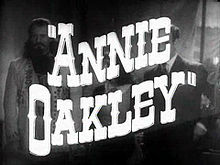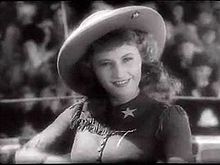Annie Oakley (1935 film)
| Annie Oakley | |
|---|---|
 Theatrical release poster | |
| Directed by | George Stevens |
| Screenplay by | |
| Story by | |
| Produced by | Cliff Reid |
| Starring | |
| Cinematography | J. Roy Hunt |
| Edited by | Jack Hively |
| Music by | Alberto Colombo |
Production company | |
| Distributed by | RKO Pictures |
Release date |
|
Running time | 90 minutes |
| Country | United States |
| Language | English |
| Budget | $354,000[1] |
| Box office | $620,000[1] |
Annie Oakley is a 1935 American Western film directed by George Stevens and starring Barbara Stanwyck, Preston Foster, Melvyn Douglas and Moroni Olsen. The film is based on the life of Annie Oakley.
Plot
In late 1800s,
At the banquet, Jeff Hogarth signs Toby to a contract, making him part of the

When the Oakleys return home, Annie promises to reimburse all those who had bet on her. Jeff follows and tells Annie that he never bet the money that she had given him. He also invites her to join the Wild West show. Annie, having developed a crush on Toby, accepts. Jeff introduces her to Buffalo Bill and the other members of the show.
When Toby overhears Buffalo Bill telling Jeff that he might have to fire Annie because she lacks showmanship, he teaches her some shooting tricks.
At the first show, Sitting Bull is in the audience. Ned Buntline, Buffalo Bill's publicist, tries to enlist Sitting Bull for the show, but Sitting Bull is bored with the acts until he sees Annie shoot five targets thrown in the air. He is impressed and changes his mind to join the show.
A romance blossoms between Annie and Toby despite Jeff's attempts to win her affections. They also become good friends with Sitting Bull.
One day, a man with a grudge tries to shoot Sitting Bull. Toby grabs the man's gun just as it fires, saving Sitting Bull's life although his eyes are affected by the closeness of the shot. While Annie's fortunes rise, Toby's decline. He hides his injury but accidentally shoots Annie in the hand and is dismissed from the show. Annie is heartbroken but Jeff and Wild Bill try to keep Toby away from her. However, during a chance meeting, Annie is told by a woman accompanying Toby that she has only brought bad luck to Toby. Although Toby tries to stop the woman, Annie feels that what she says is true and unhappily retreats. After a triumphant tour of Europe, the show plays in New York City, where Sitting Bull spots Toby and reunites him with Annie.
Cast

- Barbara Stanwyck as Annie Oakley
- Preston Foster as Toby Walker
- Melvyn Douglas as Jeff Hogarth
- Moroni Olsen as Col. William F. "Buffalo Bill" Cody
- Pert Kelton as Vera Delmar
- Andy Clyde as James MacIvor
- Chief Thunderbird as Sitting Bull
- Dick Elliott as Major Ned Buntline (uncredited)
- Theodore Lorch as Wild West Show Announcer (uncredited)
- Margaret Armstrong as Mrs. Oakley
- Delmar Watson as Wesley Oakley
- Adeline Craig as Susan Oakley
- Crown Prince Wilhelm(uncredited)
- Brandon Hurst as Doctor (uncredited)
- Philo McCullough as Officer (uncredited)
- Robert McKenzieas Sheriff Bixby (uncredited)
- Blue Washington as Cook (uncredited)
Production
The film was the first Western for both Stevens and Stanwyck.[2] While based on the real life of Annie Oakley, it took some liberties with the historical details. The film focuses primarily on Oakley's love affair with Toby Walker (representing Oakley's real-life husband Frank E. Butler) rather than on her career as an exhibition sharpshooter. It also does not depict how Butler, himself a skilled marksman, willingly ceded the spotlight to Oakley in the Wild West shows. Several of the film's scenes, such as those in which Oakley deliberately loses a shooting match and Oakley and Walker are reunited by Sitting Bull, were likely concocted to appeal to contemporary audience tastes and expectations.[3]
The working title for the film was "Shooting Star."[4]
Reception
The film was released less than ten years after the death of the real-life Oakley.[3] It returned a profit of $48,000.[1]
Andre Sennwald of
Decades later, Pauline Kael called Stanwyck "consistently fresh and believable" and wrote that Stevens "makes some of the points about race he made later in Giant... but here they're lighter and better. They seem to grow casually out of the American material; the movie feels almost improvised."[2]
References
- ^ a b c Richard Jewel, 'RKO Film Grosses: 1931-1951', Historical Journal of Film, Radio and Television, Vol 14 No 1, 1994 p56
- ^ a b Landazuri, Margarita. "Annie Oakley (1935) - Article". Turner Classic Movies. Retrieved November 29, 2022.
- ^ a b "Annie Oakley on Stage and Screen". American Experience. PBS. Retrieved May 29, 2012.
- ^ "AFI|Catalog". catalog.afi.com. Retrieved January 24, 2020.
- ^ Sennwald, Andre (December 24, 1935). "Barbara Stanwyck, Not to Mention Chief Thunderbird, in "Annie Oakley," at the Astor Theatre". The New York Times. Retrieved May 29, 2012.
External links
- Annie Oakley at the American Film Institute Catalog
- Annie Oakley at the TCM Movie Database
- Annie Oakley at IMDb
- Annie Oakley at AllMovie
